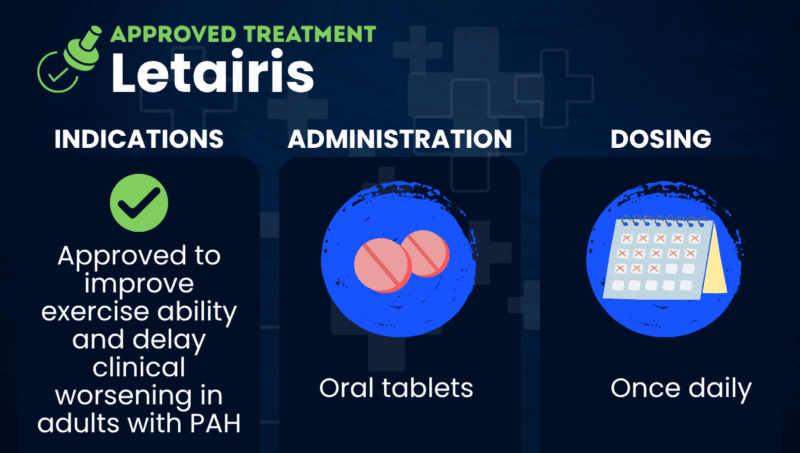Letairis (ambrisentan) for pulmonary arterial hypertension
What is Letairis for pulmonary arterial hypertension?
Letairis (ambrisentan) is an oral therapy approved to improve exercise ability and delay clinical worsening or disease progression in adults with pulmonary arterial hypertension (PAH). It can be taken alone or in combination with Adcirca (tadalafil).
In PAH, the vessels that carry blood from the heart to the lungs — the pulmonary arteries — become narrowed, causing the pressure in them to rise and forcing the heart to work harder to pump blood. Symptoms like shortness of breath, chest pain, and muscle fatigue can make it more difficult to be active.
Pulmonary artery narrowing occurs in part because of over-contraction of the muscles that line blood vessel walls, a process mediated by the endothelin-1 signaling molecule. Taken as oral tablets, Letairis is designed to block the binding of endothelin-1 to receptor proteins that cause muscle contraction, while allowing it to still bind to receptors that help blood vessels widen. The net result is that the pulmonary arteries relax and widen, reducing blood pressure and enabling better blood flow. This should ease symptoms and increase exercise capacity.
Gilead markets Letairis in the U.S., while GlaxoSmithKline markets it in Europe and elsewhere under the brand name Volibris. Generic versions are also available.
Therapy snapshot
| Brand name | Letairis |
| Chemical name | Ambrisentan |
| Usage | Used to improve exercise ability, delay clinical worsening, or reduce the risk of disease progression in adults with PAH |
| Administration | Oral tablets, taken alone or with Adcirca |
Who can take Letairis?
Letairis is approved in the U.S. for adults with PAH (World Health Organization Group 1) to:
- improve exercise ability and delay clinical worsening when used as a monotherapy
- improve exercise ability and reduce the risks of disease progression or hospitalization for worsening PAH when used in combination with Adcirca
In Europe, it is indicated for PAH patients who are in WHO functional class II or III, corresponding to slight or marked limitations in physical abilities.
Letairis comes with a boxed warning that it could cause harm to a developing fetus. As such, the medication is contraindicated during pregnancy. It also should not be used by people with the lung disease idiopathic pulmonary fibrosis.
How is Letairis administered?
Letairis is available as film-coated oral tablets that should be taken once daily, with or without food. The tablets should be swallowed whole, and shouldn’t be split, crushed, or chewed.
The recommended daily dose is 5 mg, which may be adjusted at monthly intervals as needed and tolerated up to 10 mg. Adcirca, also typically taken as daily oral tablets, may be initiated at the same time, with a starting dose of 20 mg that can be increased as needed to 40 mg.

Letairis in clinical trials
The approval of Letairis as a standalone therapy for PAH was supported by the Phase 3 ARIES trials (NCT00091598) and their long-term extension study.
- Data from ARIES-1 (NCT00423748) and ARIES-2 (NCT00423202) showed that 12 weeks (about three months) of treatment with Letairis at any of three daily doses led to a significant increase in exercise capacity compared with a placebo. The medication was also associated with a significant delay in clinical worsening, improvements in WHO functional class, and other benefits reflecting reduced disease severity.
- Data from ARIES-E (NCT00578786), the open-label extension study, showed that after two years, individuals receiving approved doses of Letairis maintained improvements in exercise capacity, with relatively low estimated rates of clinical worsening (28%) or death (12%).
Another Phase 3 trial called AMBITION (NCT01178073) supported Letairis’ indication for use in combination with Adcirca. The results showed that when used as a first-line treatment, the Letairis-Adcirca combination reduced the risk of clinical worsening, hospitalization for PAH worsening, or death by about 50%. The combination also led to significantly greater increases in exercise capacity than either therapy alone.
Letairis side effects
The most common side effects of Letairis when taken alone include:
- swelling of hands, legs, ankles, and feet (peripheral edema)
- stuffy nose
- inflamed nasal passages
- flushing, or reddening of the skin
When taken alongside Adcirca, the most common side effects include:
- peripheral edema
- headache
- stuffy nose
- cough
- low red blood cell counts and/or hemoglobin levels (anemia)
- indigestion
- chest cold (bronchitis)
Per the boxed warning, Letairis could cause major birth defects if used in pregnant patients. Pregnancy must be ruled out in female patients of reproductive potential before treatment is initiated. Effective contraception should be used before starting Letairis, throughout treatment, and for one month after discontinuation.
If pregnancy occurs, patients should immediately alert their healthcare team, as Letairis needs to be discontinued as soon as possible.
Letairis also comes with a warning for less common, but potentially serious side effects, including:
- clinically significant fluid retention that requires intervention or hospitalization for heart failure, especially when used with Adcirca
- reduced sperm count
- clinically significant anemia requiring a blood transfusion
If fluid accumulation in the lungs occurs with Letairis, it could be a sign of pulmonary veno-occlusive disease (PVOD), a rare cause of PAH. If PVOD is confirmed, Letairis may need to be discontinued.
Pulmonary Hypertension News is strictly a news and information website about the disease. It does not provide medical advice, diagnosis, or treatment. This content is not intended to be a substitute for professional medical advice, diagnosis, or treatment. Always seek the advice of your physician or other qualified health provider with any questions you may have regarding a medical condition. Never disregard professional medical advice or delay in seeking it because of something you have read on this website.

 Fact-checked by
Fact-checked by 


